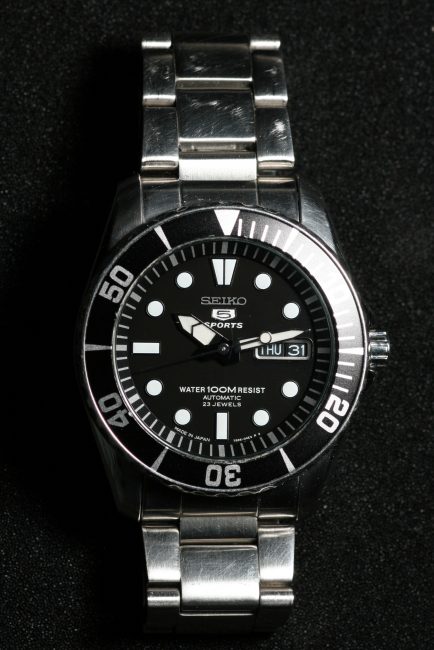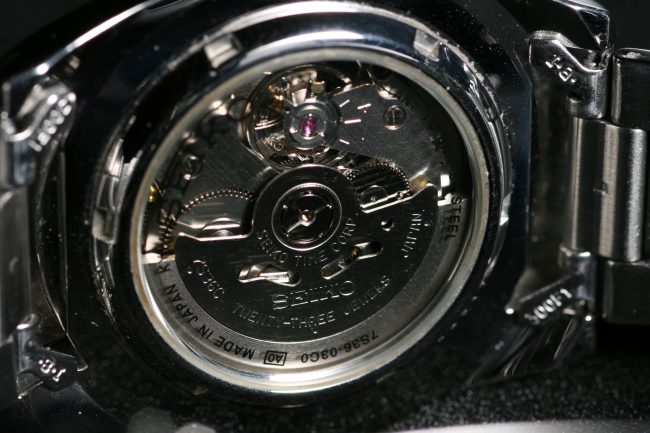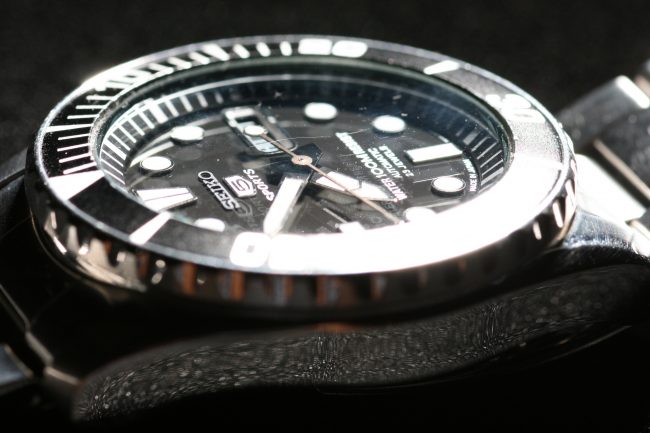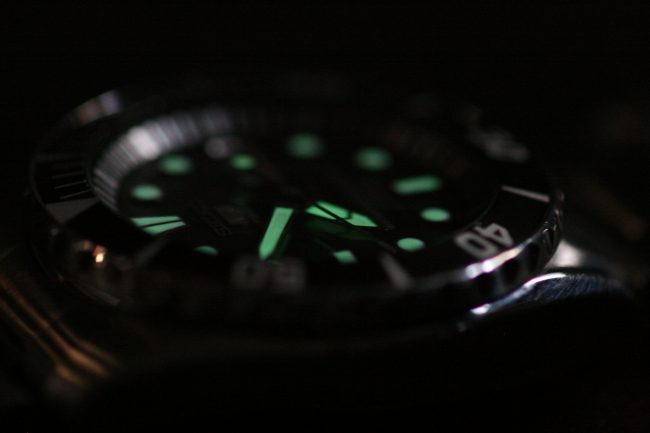
Please welcome occasional commenter and new contributor “Mozzie”, whose username (and real name) suggest that he originally hails from an area now described with a -stan in its name. I’ve been sitting on a great piece of his about human vocal dynamics — no doubt figuring that I was too much of an ignoramus to edit that one, he has now sent me a simple watch review. Enjoy! — jb
The last time I owned a mechanical wristwatch was in the mid 1990s. As a young boy I didn’t know the limits of Soviet-era watchmaking capabilities and therefore lost the piece to moisture. Since then any watch I wore has been quartz-based, be it a Casio, Timex, or an analog fashion watch. In March of this year, having suffered through (he didn’t originally write “suffered through”, that’s an edit — jb) hours of the Watch & Listen podcast, I ordered the Seiko SNZF to complement my to-date favorite everyday watch, a Timex Expedition chronograph.
There are several reasons I chose this particular timepiece. One of my college jobs was in retail luxury goods, so I had hands-on experience with Swiss brands using ETA and in-house movements. As a result, being able to see the movement was high on my priority list. There are few options in this price range with a display back. I also wanted something I could wash with soap and water regularly, unlike my Timex with the leather strap. The Seiko “Sea Urchin” was the only option in my price range with solid end links. Lastly, the 42mm case size was just right for my dainty wrist.
When the Seiko arrived I had a moment of worry that I had ordered incorrectly; the day of the week was in Arabic script. The quick reference guide provided by Jomashop assured me the Seiko was bilingual. Of all the mechanical chronographs, perpetual calendars, or single or multi-axial tourbillons I encountered, I can’t recall ever coming across a multi-lingual complication. (This is common with Seiko 5s — the day window usually has a couple different languages on it — jb) Once the day of the week preference was set, I realized I’d forgotten all about band sizing when I made the purchase. Using a combination of unapproved tools and materials available to me at the house, I managed to get the size just right.
Half a year or so later with nearly daily use, the Seiko is still a pleasure to wear. It’s hefty enough to feel present, but is in no way bulky. The time keeping (as expected) is about three minutes off per month, in this case running too fast rather than too slow. The movement is quiet enough to make me have to expend considerable effort to hear the tick of the mechanism. The links show more wear on one side than the other. I don’t dive or do much swimming, so I can’t say much about its water resistance. The deepest it has gone on my wrist has been in a hot tub.
Despite occasional mild kayaking and regular washing, moisture has not been an issue. I noticed one quirk with the bezel ring: When it’s dry the action feels very stiff. After washing it the ring is dependably easy to turn. Where I live in Colorado it seems plausible the lack of humidity is at play, although the more likely answer is my ignorance of the mechanism’s true nature. One of my favorite features of the Timex Expedition is the backlight of the analog dial. I was concerned the lume of the Seiko would not work as well in the middle of the night, either at home or while camping. Although the brightness consistently degrades with the progress of the night, unlike with the Indiglo, I have come to prefer the Seiko. Using the Indiglo at night in the past was never an issue, but the Seiko lume is just bright enough for legibility, while being in no way so bright as to be disruptive. This preference very well may be a matter of adaptation on my part.
The glass, although not sapphire, has yet to show a scratch (when not photographed with a macro lens) despite various collisions with door knobs, railings, or other harsh use scenarios endemic to the suburban lifestyle. The reviews I took in from various online resources suggested Seiko’s glass formulation was almost as good as sapphire. I can’t substantiate that claim, nor have I run a key across the glass, but I have found one superiority it may claim over sapphire; the lack of a purple hue makes the black dial look truly black in all lighting conditions. In my experience black-dialed watches appear to have a dark blue tinge to them when viewed through sapphire. The display back window, also mineral glass, provides a fun view of the moving pieces of the movement, which obviously lacks decoration and presents just one visible bearing.

On several occasions during his time as host of the Watch & Listen podcast, Matt Farah pointed out that finish of the underside of the hands on his Grand Seiko (GS) appeared to be the same as that of the topside, visible in the dial reflection. Although nowhere near the brand positioning of the GS, the Sea Urchin’s hands are painted on the underside in the same pattern as the topside.

In the process of writing this piece I had to question whether the underside of the hands are lumed as well. If you can forgive my photography, you may see that they are indeed lumed. At first I though the second hand was also, but I think it is just a reflection.

I am left with two theories which I expect to be completely erroneous. The Seiko hands are either made identically on both sides to ease assembly, or the technicians can’t let the pieces leave production in an unfinished state. If I were writing this piece like a game review, I would follow former GFW’s managing editor Sean Molloy’s this-but-this mock formula and add some negative critisisms about the Seiko to seem balanced. The truth is that I read and listened to other people’s opinions about this timepiece before buying it, and I got what I mostly expected. I am pleased with the timepiece, and have been pleasantly surpried by some of its features. Having gotten used to this mechanical piece of timekeeping I am unsurprisingly looking through the Crown & Caliber site for others. The question now is: when will I spring for another wristwatch that needs neither a battery nor sunlight?







24 Comments
Nice write up. I have two SNZG which is the field watch version with this movement. The both run fast. One gaining over ten minutes a day making the watch mostly unusable as a timepiece. After digging around I found instructions on how to adjust the timing. In the pic of the movement you can see a +/-. There are two “levers” you can rotate, only one of which is the adjustment for timing. The tutorial cautioned against accidentally touch the lower lever lest you brick the entire thing making it completely unusable as a timepiece. I headed over to Amazon and purchased a lighted magnifying glass on a stand and proceeded to remove the caseback and try and make the adjustments. It’s mostly a trial and error process so I made a small adjustment and tested it out. Still too fast. Another small adjustment and still no improvement. On the third attempt I slipped and hit the parts that I was told not to hit. The movement stopped along with my heart. Momentarily. I tapped the case and it fired back up. After wearing it for a day it seemed that I had managed to get the timing right then it stopped moving again and I haven’t been able to fix that yet. I haven’t opened it back up yet so I’m not sure if it’s damaged permanently. I have a couple SKXs that gain time too. I’m not sure how I managed to get such unreliable examples of what’s supposed to be some of the most reliable movements out there.
Thanks Jonathan. At this stage the timekeeping is not a severe enough of an issue for me to crack open the case and experiment with the adjustment. Here’s a wild theory about your timepieces: have they been exposed to magnetic fields?
It’s possible, and I’ve considered it but I have other brand automatics(Citizen, Victorinox) that don’t have the problem. I ran one of my SKXs over the magnetic security device deactivator at the grocery before with no luck. Seiko requires any regulating to be done along with a full service which is north of $150 so that’s not a great option. My local watch repair place only does high end watch stuff.
That is a lovely watch. I recently bought a 6139 with the gold face. I’d always hankered after it as a kid. Even after 40 odd years it still works great.
Mozzie, thank you for the review of your Seiko SNZF. I am a lifelong Seiko fan as these were the first watches of any quality that I could afford and my affection for them has never faded. This morning I have on my wrist a Seiko Quarts “Sports 100″ that have been enjoying for 40 years. It stopped running a few years ago and I sent it the Seiko Service Center in New Jersey where for a modest fee it was serviced, cleaned, and restored to working condition.
Seiko doesn’t get much respect from the Euro Watch Snobs, but the company has been perhaps the most significant player in modern horologic history. They are still making solid, reliable time pieces for watch enthusiast of every stripe.
” . . . I read and listened to other people’s opinions about this timepiece.”
Of course the only opinion that matters is yours. Enjoy your watch!
-Scott
Scott, in my experience the snobbery, which to me is a perception function, can go so far as to lead some buyers to discriminate between two Swiss brands based on the inexplicable value of prestige. My familiarity with Seiko’s history is very superficial, but I expect it will be comparable to what other Japanese brands contributed to the industries of photographic equipment and automobiles, although perhaps not in the same quantities.
Mozzie, what ever happened to your original Russian/Soviet? watchmaker? Did they get there self together, or did they give up in the face of the Asian horde?
John, I don’t know. The closest answer I can provide is that it looked like this with a black strap, although to the nine year old me the background was a darker blue: https://www.etsy.com/listing/666622729/vintage-watch-pobeda-watch-ship
Sadly the real answer is probably many feet deep in a central European landfill. “Pobeda” means victory [insert ftw pun here]
Great watch. Like Jonathon, I had a Seiko SNZG that ran fast. A Seiko Cocktail time could be your next watch. It’s an auto with a cool post-modern vibe.
Id really like to find a semi-affordable US assembled/made watch. Except for Weiss, it’s hard to find something around, or below, $1000. Any suggestions?
Shinola has a good selection of watches under $1,000 that are assembled in the US. I have a the Bronze Monster with SW200 caliber and I enjoy it very much.
-Scott
I should’ve clarified to avoid a fashion brand like Shinola. Some look good though.
Texn -Take a look at Vaer watches for US assembly (quartz and automatics)
Looks nice, is it an autowind ? .
Are all SEIKO watches made in Japan ? .
When I tried to look up this model on Amazon it changed to SNZG no matter what I typed in….
-Nate
Many are made in Malaysia. Dont think any Seiko5 is made in China however.
Nate, it is indeed. At the time I bought it Jomashop had two origin options. I paid a little bit more for the Japanese version. I checked their website just now and couldn’t find it.
Thanx guys ! .
When I was looking at the Seikos on amazon they had several really basic looking analog ones I liked .
Gotta figure out how to work $250 + into my budget, the slushbox on my 40 year old Mercedes just exploded….
-Nate
The Japanese watches usually have a J at the tail end of the model number. From what I’ve read there’s virtually no difference in quality or performance between the Japanese and Malaysian models.
Thank you yet again .
-Nate
Jack, as a horological expert and a proud American patriot who appreciates well-made goods manufactured in our country, do you know of any analog watches made in the USA? I recall your previous posts about Shinola’s assembly in the US. Any others?
Weiss (handwound Unitas clone made in USA)
RGM (bespoke movement made in USA)
Vortic (rebuilt USA pocketwatch movements re-cased in Fort Collins, CO)
Is SNZF a model designation? The seiko website seems to be useless.
If we can trust this site it is a retail reference. It’s printed on the box: http://www.watchsleuth.com/seikodatefinder/
Do you happen to know what the equivalent women’s would be? I think this would make a good gift.
I don’t know if there is. Depending on the recipient this one could work; there are larger case sizes for ladies on offer by the haute horlogerie brands.